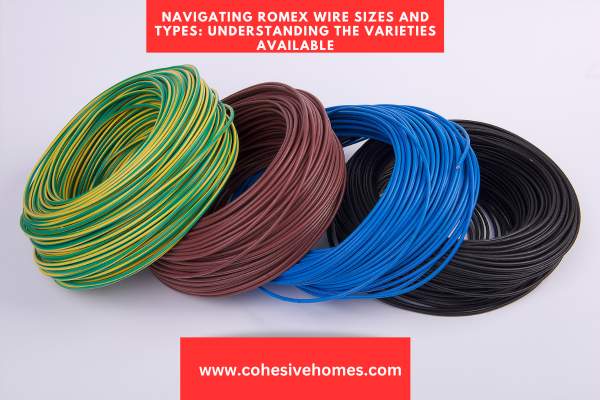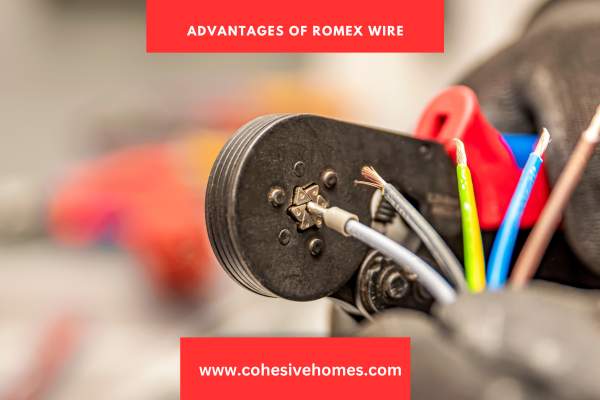In the intricate world of electrical wiring, the right choice of wire can make all the difference between a safe, efficient electrical system and a potential hazard waiting to happen. Among the various types of electrical cables available, one name stands out for its versatility, reliability, and widespread use: Romex wire.
This unassuming yet indispensable wire has revolutionized the way professionals and DIY enthusiasts design and install residential and commercial electrical systems, making it a subject of great interest.
In this blog post, we will take an in-depth look at Romex wire, exploring its composition, applications, and advantages that have contributed to its popularity in the field of electrical installations. Whether you’re an aspiring electrician, a homeowner embarking on a wiring project, or simply curious about the inner workings of your electrical system,
This article will shed light on the vital role that Romex wire plays in modern construction and electrical engineering.
The Origins of Romex Wire: Tracing Its Evolution in Electrical Wiring

Romex wire, also known as non-metallic sheathed (NM) cable, has a rich history dating back to the mid-20th century.
It innovatively replaces metal conduit and individual wires for electrical installations, offering a more efficient solution.
The invention of Romex wire revolutionized the field of electrical wiring, simplifying the installation process and improving safety standards.
In the late 1920s, a company called Rome Wire Company, based in Rome, New York, introduced a new type of cable that consisted of multiple insulated wires encased in a protective sheathing.
This early version of Romex wire laid the foundation for what would become a widely adopted wiring method.
The Southwire Company played a pivotal role in the true breakthrough of Romex wire in the 1940s as they developed and refined it.
Southwire introduced the use of plastic insulation as a replacement for the previously used rubber insulation, making the cable more durable, flexible, and resistant to moisture and heat.
Over the years, Romex wire continued to evolve and adapt to meet the changing demands of electrical systems.
Newer versions incorporated additional layers of insulation and improved features, including increased fire resistance and better protection against electrical interference.
Today, Romex wire has become the go-to choice for residential and commercial electrical installations in many countries.
Its cost-effectiveness, ease of installation, and compliance with electrical codes and regulations contribute to its widespread use.
As we explore the origins and evolution of Romex wire, we gain a deeper appreciation for the advancements that have shaped the electrical wiring industry and paved the way for safer and more efficient electrical systems.
What Makes Romex Wire Unique: Key Features and Advantages

Romex wire, or NM cable, is a widely used electrical wiring solution with unique features.
Its distinct characteristics and advantages have made it a popular choice in residential and commercial settings. Here are some key features that set Romex wire apart:
- Simplicity and Convenience: Romex wire simplifies the electrical installation process by combining multiple insulated wires within a single sheathed cable. This eliminates the need for individual wires and separate conduits, saving time, effort, and reducing the complexity of wiring projects.
- Versatility: Romex wire comes in various sizes and types to accommodate different electrical applications. Romex wire handles diverse electrical needs, from basic circuits to high-demand appliances, offering versatility for all installations.
- Insulation and Protection: Romex wire is constructed with layers of insulation to provide excellent protection against electrical shocks and potential damage. The outer sheathing acts as a barrier against moisture, abrasion, and physical impact, ensuring the safety and durability of the electrical system.
- Cost-Effective: Compared to other wiring methods, Romex wire is generally more affordable.
Bundled construction reduces materials and simplifies installation, resulting in cost savings for professionals and DIY enthusiasts. - Code Compliance: Romex wire meets the requirements of electrical codes and regulations in many jurisdictions. Rigorous testing ensures Romex wire meets safety standards, providing peace of mind for correct and code-compliant installations.
- Easy Identification: Romex wire is color-coded for easy identification and proper installation. Each wire within the cable has a specific color to indicate its function, such as hot, neutral, and ground. This helps electricians and installers correctly connect the wires, reducing the risk of wiring errors.
- Space Efficiency: The compact design of Romex wire saves space within electrical boxes and conduit systems. Efficient space utilization benefits retrofit projects and limited spaces, optimizing space utilization effectively.

When it comes to Romex wire, understanding the different sizes and types available is essential for selecting the appropriate wire for your electrical project.
Categorizing Romex wire is based on its gauge size, number of conductors, and specific applications.
Here’s a brief overview to help you navigate through the various Romex wire sizes and types:
Gauge Sizes
Romex wire is available in different gauge sizes, which indicate the diameter and carrying capacity of the wire. The most common gauge sizes for residential applications are 14, 12, and 10. The smaller the gauge number, the larger the wire, and the higher its ampacity (current-carrying capacity).
Number of Conductors
Romex wire consists of multiple conductors within a single cable. The most common types are:
a. 2-wire (plus ground): This type of Romex wire contains two insulated conductors for hot and neutral connections, along with a bare or green-insulated grounding wire.
3-wire (plus ground): This Romex wire adds an additional insulated conductor, allowing for separate circuits or specific applications that require an additional hot wire.
Applications
Romex wire is designed for various applications within electrical installations. Some common types include:
a. NM-B, or non-metallic sheathed cable, serves as the standard Romex wire used for general residential and commercial wiring applications, including lighting, outlets, and small appliances.
It is available in different gauge sizes and conductor configurations.
Underground Feeder (UF): UF-B Romex wire is specifically designed for direct burial applications, such as outdoor lighting, underground circuits, and outdoor wiring projects. It is resistant to moisture and suitable for installation in wet locations.
Heat-Resistant (XHHW-2): XHHW-2 Romex wire is designed to withstand higher temperatures, making it suitable for applications where the wire may be exposed to excessive heat or in areas with high ambient temperatures, such as attics or mechanical rooms.
Navigating Romex wire sizes and types requires consideration of the specific electrical requirements and environmental conditions of your project.
Understanding the gauge sizes, number of conductors, and application-specific variations ensures you choose the right Romex wire to meet your wiring needs safely and efficiently.
Advantages of Romex Wire

| Advantages of Romex Wire |
| Simplifies electrical installation by combining multiple insulated wires within a single sheathed cable. |
| Versatile and suitable for a wide range of residential and commercial electrical applications. |
| Provides excellent insulation and protection against electrical shocks, moisture, abrasion, and physical impact. |
| Cost-effective compared to other wiring methods, saving both time and money during installation. |
| Complies with electrical codes and regulations, ensuring a safe and compliant electrical system. |
| Color-coded for easy identification and proper connection of wires, reducing the risk of wiring errors. |
| Compact design saves space within electrical boxes and conduit systems. |
| Widely available and easy to find in different sizes, types, and lengths for various project requirements. |
Romex wire’s unique combination of simplicity, versatility, insulation, cost-effectiveness, compliance with codes, easy identification, and space efficiency make it a highly advantageous choice for electrical wiring projects in residential and commercial settings.
Installing Romex Wire: A Step-by-Step Guide for DIY Enthusiasts
- Assess project requirements and gather necessary tools and materials.
- Turn off power at the main breaker panel and use a voltage tester to ensure it’s de-energized.
- Plan the routing and placement of electrical boxes.
- Run Romex wire along the planned route, securing it with plastic staples.
- Make connections following proper wiring practices within electrical boxes.
- Install devices (outlets, switches) and complete wiring according to manufacturer instructions.
- Test each outlet/switch for functionality and secure the Romex wire within the boxes.
- If unsure or for complex projects, consult a qualified electrician for safety and compliance.
Romex Wire vs. Other Wiring Methods: A Brief Comparison

When it comes to electrical wiring, Romex wire has gained widespread popularity, but it’s important to understand how it compares to other wiring methods.
Romex wire, also known as NM cable, offers simplicity, cost-effectiveness, easy installation, compliance with codes, and space efficiency.
It combines multiple insulated wires within a single sheathed cable, making it ideal for residential and commercial applications such as lighting, outlets, and small appliances.
Conduit wiring, on the other hand, utilizes metal or plastic pipes (conduits) to protect individual wires.
It provides enhanced protection against physical damage, flexibility in wire placement, and ease of maintenance.
Conduit wiring finds common use in industrial settings, commercial buildings, outdoor installations, and areas with exposed wiring.
BX cable, or armored cable, consists of individually insulated wires encased in a flexible metallic sheathing.
It offers high durability, resistance to physical damage, and enhanced protection against electrical interference.
BX cable finds applications in commercial and industrial settings, exposed wiring, and installations requiring additional mechanical protection.
Electrical Metallic Tubing (EMT) is a type of metal conduit made of thin-wall steel or aluminum. It provides excellent mechanical protection, grounding capabilities, and ease of installation.
EMT commonly sees use in commercial and industrial settings, outdoor installations, and areas that require rigid and durable wiring protection.
Choosing between Romex wire and other wiring methods depends on factors such as specific project requirements, local electrical codes, and the level of protection and flexibility needed.
To ensure safety standards and code compliance, it is crucial to consult with a qualified electrician or follow local regulations when selecting the appropriate wiring method for a specific application.
Conclusion

In conclusion, when comparing Romex wire to other wiring methods, it becomes evident that Romex wire offers several advantages, including simplicity, cost-effectiveness, easy installation, compliance with codes, and space efficiency. It is a versatile option suitable for residential and commercial applications.
However, other wiring methods like conduit wiring, BX cable, and EMT have their own unique benefits, such as enhanced physical protection, durability, and flexibility.
The choice between Romex wire and other wiring methods depends on project requirements, local electrical codes, and the desired level of protection and flexibility.
To ensure safety and code compliance, it is crucial to consult with a qualified electrician or adhere to local regulations when selecting the appropriate wiring method.
Ultimately, understanding the characteristics and applications of Romex wire and other wiring methods empowers individuals to make informed decisions and choose the most suitable option for their specific electrical projects.
FAQS
Is Romex wire suitable for outdoor installations?
Romex wire primarily serves indoor use and experts do not recommend direct exposure to outdoor elements. UF-B Romex wire is a suitable choice for outdoor installations.
Can Romex wire be used in commercial or industrial settings?
Romex wire is commonly used in residential applications and may not be the most suitable choice for commercial or industrial settings. Conduit wiring or armored cable is often preferred for these environments.
Can Romex wire be used in exposed locations?
No, Romex wire is not designed for exposed locations where it can be subjected to physical damage or excessive moisture. Other wiring methods, like BX cable or EMT, provide better protection for such installations.
